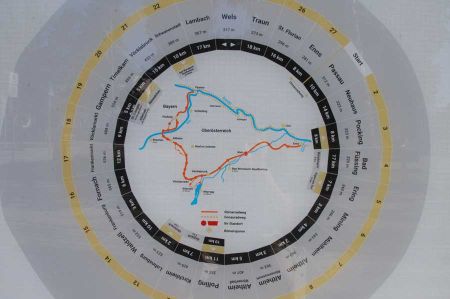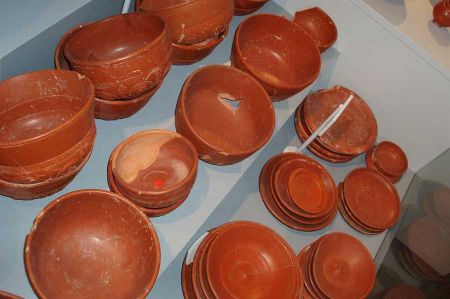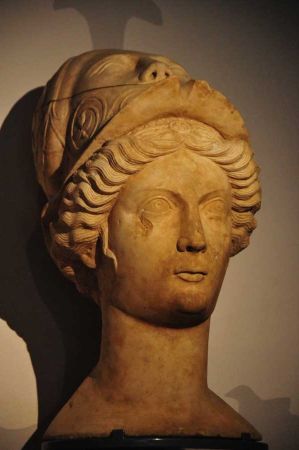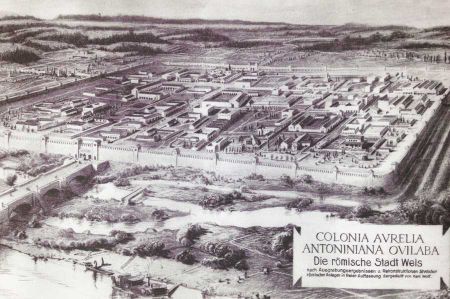Wels - Remains of the Roman city wall in Schubertstraße
- Written by Portal Editor
At first, it was just a poster on the banks of the Traun, which drew our attention to the Roman past of the modern town of Wels.
Once a small settlement, Ovilava, how Wels was called at the time, became an important base and outpost of the Roman Empire. Under the Emperor Hadrian, Ovilava was elevated to a city, known in Roman as "municipium". The built-up area included the area from the Traun river to the height of today's Kaiser-Josef-Platz. There were already brick-built houses, various steam baths, an arena and an irrigation system that brought water from Reinberg into the city, which lies on the other side of the Traun.
As a result, Wels (Ovilava) was growing to a large city under the rulership of Emperor Caracalla, the Romans named then with "colonia". Due to the imminent threat of Alemannic, the city was extended, surrounded by a massive city wall - the area was already about 90 ha in size - and built along the road from Passau along the Danube. The ancient Roman road (parallel to the Traun) ran above swamp and flood risk on the slope of the Reinberg, later densely built section of the here very narrow former Pyhrn highway, such as the castle, where the Bruckhofstraße branches off. What is certain is that six towers and a gate system were integrated into the walls, which was built from the castle along the western railway line and back across the Feldgasse in the direction of the Traunufer.
Ovilava becomes the capital between Inn and Danube
 As part of his reform of the provincial system, Emperor Diocletian made Wels a capital that administered the territory of the Roman Empire north of the Alps, the Noricum Ripense. Two Duumviri acting as city magistrates, two aediles advocating compliance with the law and market rights, a quaestor managing the city treasury, and a 100-member city council headed the city.
As part of his reform of the provincial system, Emperor Diocletian made Wels a capital that administered the territory of the Roman Empire north of the Alps, the Noricum Ripense. Two Duumviri acting as city magistrates, two aediles advocating compliance with the law and market rights, a quaestor managing the city treasury, and a 100-member city council headed the city.
Ovilava administered an area enclosed by Inn and Danube, east of the administrative areas of Lauriacum (Enns) limited to Bad Ischl. To the municipality counted border fortifications belong, which included Linz (Lentia) and Passau (Boiodurum) and countless settlements on Upper Austrian and Salzburg soil.
Tomb culture in Ovilava - something special
Striking at the Roman graves culture in Wels is that only few precious things were buried with. This had its cause on the one hand in the near border with constantly threatening robberies and wars, on the other hand in the severe climate, which is why only a few rich citizens settled. Richer graves come from earlier periods of settlement.
From the 3rd to the 5th century, the area around Wels was often invaded by Germanic and Vandal tribes as well as by Attila's army in the course of the incipient migration of peoples. Under Emperor Gallienus, the province of Noricum was described as devastated. The officer and king of Italy, Odoacer, had evacuated Noricum, as it was unstoppable.
From the 4th century on, Wels may have become a small and insignificant settlement for several centuries.
Statuettes - the Venus of Wels
At the time of the Romans, agriculture and border trade as well as brick production, pottery and stone mining were the economic bases of the city. The cultivation of grain just covered the regional consumption, probably cattle and horses were exported. In today's urban area, the oldest granary was found in the eastern Alps, where, according to the findings, mainly wheat, dwarf wheat, emmer, barley and rye were stored.
Since several Roman imperial roads ran through the city, including the large east-west connection to Enns, many goods from the West, such as from Gaul and the Rhine area were imported, including terra sigillata vessels and statuettes, including the so-called "Venus of catfish". One found amphorae carried oyster shells and bronze figures of Italian origin.
Architectural achievements in Wels
 On the right bank of the river Traun, a water pipe was located between the railway bridge and the road bridge across the river. The archaeologist Nowotny succeeded in proving two construction phases, one of the 2nd century AD in wood and the extension in stone of the 3rd century AD.
On the right bank of the river Traun, a water pipe was located between the railway bridge and the road bridge across the river. The archaeologist Nowotny succeeded in proving two construction phases, one of the 2nd century AD in wood and the extension in stone of the 3rd century AD.
In the western part of the city, near the east-west thoroughfare, a bronze deposit was found, consisting of bronze and terra sigillata crockery and iron equipment and a bronze statuette of a genius sitting on a chair. A coin from the overlying fire layer and the terra sigillata vessels dated the find in the first half of the 3rd century AD.
Terra Sigillata (TS) is the modern designation of a particular category of Roman crockery made of ceramic, which dates back to the end of the 1st century BC. In Italian workshops (Arezzo) they were developed. The upscale tableware was produced in large quantities in craft workshops (manufactories), which usually provided their goods with a seal of manufacture. The goods were sold in different variations throughout the Roman Empire.
The Terra Sigillata Museum in Rheinzabern (Rhineland-Palatinate) shows archaeological finds from probably the most important pottery operation of the Roman era in Germany. These are predominantly fine-ceramics tableware, so-called Terra Sigillata, which found high sales in the northwestern provinces of the Roman Empire.
Tombstone of the Ursa
 There are indications that a pontiff and the Quorum of Sexviri, a community dedicated to the imperial cult, were established. Their temple, dedicated to the Capitoline Trias, has not yet been found. For other gods and spirits, such as Apollo, Jupiter, Vulcanus, Genius and Laren, however, sacred stones were found. Some statues of Diana, Venus, Fortuna, Mercurius and Minerva could also be excavated.
There are indications that a pontiff and the Quorum of Sexviri, a community dedicated to the imperial cult, were established. Their temple, dedicated to the Capitoline Trias, has not yet been found. For other gods and spirits, such as Apollo, Jupiter, Vulcanus, Genius and Laren, however, sacred stones were found. Some statues of Diana, Venus, Fortuna, Mercurius and Minerva could also be excavated.
The Celtic world of gods could only be proven by a statue of a mother goddess and an image of the Celtic bull god Tarvos Trigaranus.
The emerging Christianity was represented in Wels since the 3rd or 4th century. These first years of the Christian religion were characterized mainly by persecution and oppression, but Florian von Lorch is said to have worked in Wels before he fled to St. Pölten. Part of a pilaster provides information about an early Christian church from the 4th or 5th century and indicates a larger Christian community.
The tombstone of the Ursa is therefore considered one of the oldest finds of an early Christian community. The tombstone was commissioned by a Roman soldier for his wife. The medallion of a Roman tombstone is now attached to a house facade on the town square.
Please read as well:
Rottweil colorful - a city also relies on guild signs
Impressions from Wels - Bicycle Order Days
